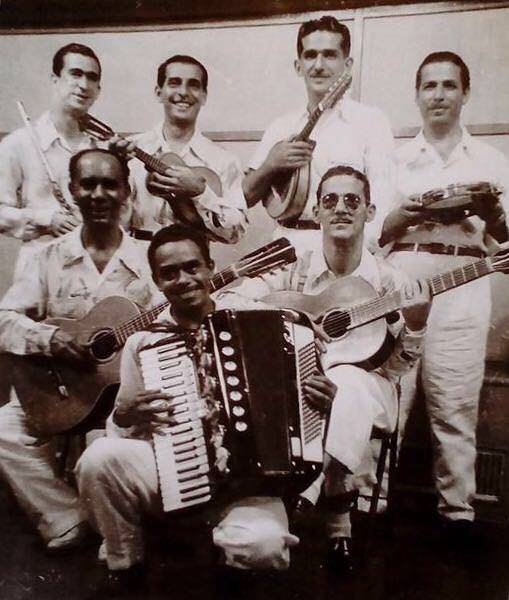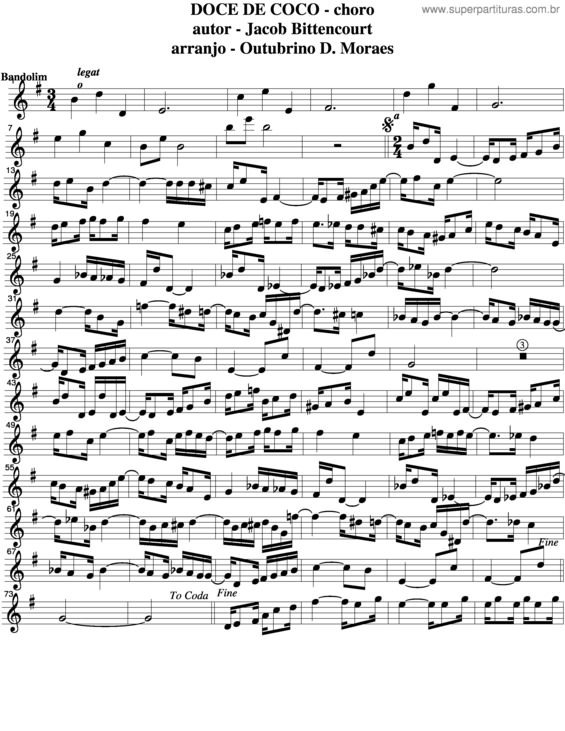Hola que tal amigos, todo un placer estar nuevamente esta semana en esta edicion #116, para esta ocasion viajaremos hasta el "Gigante delSur", Brasil, y su "Doce de coco", es una hermosa pieza musical compuesta por, JACOB PICK BITTENCOURT, mejor conocido como "Jacob do Bandolim", Nacido el 14 de febrero de 1918, en la ciudad de Rio de Janeiro. Desde muy pequeño acostumbraba, desde la ventana, oír a un vecino francés ciego tocar un violín. Y ese fue su primer instrumento. Lo ganó de la madre a los 12 años, pero, por no poder adaptarse al arco del instrumento, pasó a usar grapas de pelo para tocar las cuerdas. Después de varias cuerdas desbaratadas, una amiga de la familia dijo; "... que ese niño quiere es tocar bandolín ..". Días después, Jacob ganó un bandolín, comprado en la Guitarra de Plata. Era un modelo "cuia", estilo napolitano, y según el propio Jacob: "... eso me arrebató los dedos todos, pero yo empecé...
Jacob del Bandolim fue un músico de "Choro", que se relacionó intensamente con este estilo de música. Su obsesión es percibida en el cuidado que éste tuvo con su archivo personal, que unía innumerables grabaciones y obras referentes sólo a este estilo. Jacob se fue firmando en el medio musical como un músico serio, muy preocupado por la preservación de las raíces culturales de su Pais, un tema muy recurrente en su obra, el argumentaba que era necesario pagar tributo al pasado, a los grandes culturores que vivieron en esa epoca.

De la polca, originaria de Europa, bailando y modulada, se originó el "Choro". En Brasil, las tres razas tristes (Indigenas, Africanos y Portugueses), cobraron su tributo haciéndola más lenta y melodiosa, pero, bailando o no, continuaron conocidas como polcas, no hay quien encuentre en impreso o disco de los más antiguos.
Tal vez podamos concluir de este pequeño relato que Jacob no sólo estaba preocupado por la preservación de la música popular Brasileña, sino también con la preservación de la cultura como un todo, y que su música pudiera de alguna forma transportar al oyente a otro momento histórico del país , por mejor o peor que fuera el pasado Brasileño.

Ahora que podemos entender un poco mejor la relación de Jacob do Bandolim con el género de "Choro" y la importancia que el compositor dio a la cultura Brasileña, podemos comprender de alguna manera la composición "Doce de Coco". Escuchando la música, se puede percibir rápidamente que este "Choro" no es tocado con tristeza, como el propio compositor describió sobre el "Choro", antiguamente. Muy al contrario, es una canción que trae una sensación alegre, otra característica que aparece en esta composición es la forma binaria, con ambas partes en la tonalidad de Sol mayor. El "Choro", tradicionalmente se compone en la forma ternaria, y sus partes se separan normalmente con la primera parte en una tonalidad, la segunda parte que va a la tonalidad relativa de la primera, y la última parte estando en la misma tonalidad de la primera parte, pero en el modo (es decir, si la primera parte estaba en G mayor, iría a G menor, y viceversa)...
Bueno amigos espero que les guste este cover, un gran abrazo ... saludos! como siempre, un agradecimiento especial a todos los personajes que hacen que todo esto suceda ... @pfunk, @ausbitbank, @curie, @verbal-d, @krystle, @aggroed, @luzcypher, @soundlegion, @passion-ground .... A todos ellos muchisimas gracias. ... !!!

English Version
Hello, such friends, it is a pleasure to be back this week in this edition # 116, for this occasion we will travel to the "Gigante delSur", Brazil, and his "Doce de coco", is a beautiful musical piece composed by, JACOB PICK BITTENCOURT , better known as "Jacob do Bandolim", born on February 14, 1918, in the city of Rio de Janeiro. From a very young age, from the window, he used to hear a blind French neighbor play a violin. And that was his first instrument. He won it from the mother at age 12, but, because he could not adapt to the bow of the instrument, he went on to use hair clips to play the strings. After several broken strings, a friend of the family said; "... that child wants to play bandolín ..". Days later, Jacob won a bandolín, bought in the Silver Guitar. It was a model "cuia", Neapolitan style, and according to Jacob himself: "... that took my fingers all, but I started...
Jacob del Bandolim was a musician of "Choro", who interacted intensely with this style of music. His obsession is perceived in the care he had with his personal archive, which linked countless recordings and works referring only to this style. Jacob was signing in the musical medium as a serious musician, very concerned about the preservation of the cultural roots of his country, a recurrent theme in his work, he argued that it was necessary to pay tribute to the past, to the great culturists who lived at that time..

From the polka, originally from Europe, dancing and modulated, the "Choro" originated. In Brazil, the three sad races (Indigenous, African and Portuguese), collected their tribute making it more slow and melodious, but, dancing or not, they continued known as polkas, there is no one to find in printed or disc of the oldest.
Perhaps we can conclude from this short story that Jacob was not only concerned about the preservation of Brazilian popular music, but also with the preservation of the culture as a whole, and that his music could somehow transport the listener to another historical moment of the country, for better or worse than the Brazilian past.

Now that we can understand Jacob do Bandolim's relationship with the genre of "Choro" and the importance that the composer gave to the Brazilian culture, we can understand in some way the composition "Doce de Coco". Listening to the music, you can quickly perceive that this "Choro" is not played with sadness, as the composer himself described about the "Choro", formerly. Quite the contrary, it is a song that brings a happy feeling, another feature that appears in this composition is the binary form, with both parts in the key of the greater Sun. The "Choro", traditionally is composed in the ternary form, and its parts are separated normally with the first part in a tonality, the second part that goes to the relative tonality of the first, and the last part being in the same tonality of the first part, but in the mode (that is, if the first part was in G major, it would go to G minor, and vice versa)...
Well friends I hope you like this cover, a big hug ... regards! as always, a special thanks to all the characters that make all this happen ... @pfunk, @ausbitbank, @curie, @verbal-d, @krystle, @aggroed, @luzcypher, @soundlegion, @passion-ground .... To all of them many thanks. ... !!!












img credz: pixabay.com
Nice, you got an awesome upgoat, thanks to @josevallera
BuildTeam wishes everyone a great Christmas and bullish Holidays
Want a boost? Minnowbooster's got your back!
Congratulations! This post has been upvoted from the communal account, @minnowsupport, by josevallera from the Minnow Support Project. It's a witness project run by aggroed, ausbitbank, teamsteem, someguy123, neoxian, followbtcnews, and netuoso. The goal is to help Steemit grow by supporting Minnows. Please find us at the Peace, Abundance, and Liberty Network (PALnet) Discord Channel. It's a completely public and open space to all members of the Steemit community who voluntarily choose to be there.
If you would like to delegate to the Minnow Support Project you can do so by clicking on the following links: 50SP, 100SP, 250SP, 500SP, 1000SP, 5000SP.
Be sure to leave at least 50SP undelegated on your account.
Luzcypher's Announcement For Steem Witness